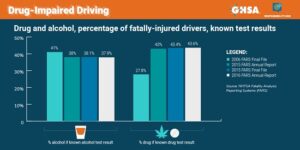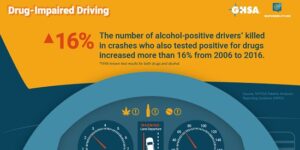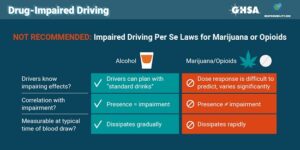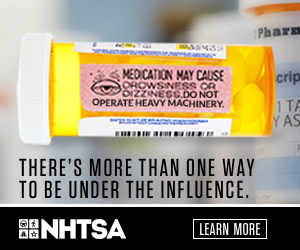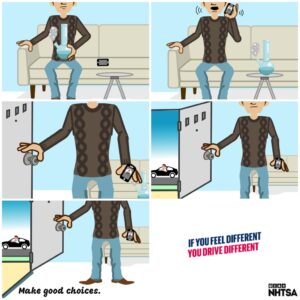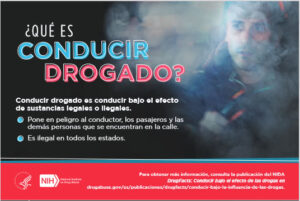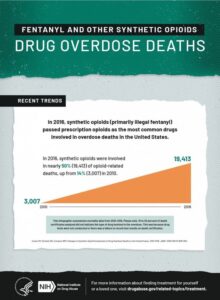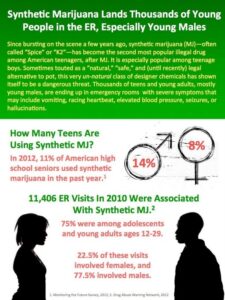Workplace Prevention
Did You Know?
The cost of impaired driving is not one that is exclusively paid by the perpetrator, you as an employer also become a victim.
Impaired driving costs lives, reputations, money and relationships, and it’s all preventable. Impaired driving costs incurred by employers include lost time, sick leave, and health insurance costs to name a few. What happens when an employee who manages your payroll, or your website, or other employees, gets arrested for driving under the influence of drugs or alcohol? What happens if an employee hits and kills someone while under the influence? It doesn’t matter if this happens on- or off-the-job. The cost of impaired driving is not one that is exclusively paid by the perpetrator, you as an employer also become a victim.
With the rise of illicit/illegal and prescribed and over-the-counter (OTC) drug use (see Prevalence section), it is critical that employers proactively address impaired driving in their workplace safety programs and include pre-planning in their business models.
A study reported by the National Institute on Drug Abuse (NIDA), found 55 percent more industrial accidents, 85 percent more injuries, and 75 percent greater absenteeism among employees who tested positive for marijuana compared to those who tested negative.
The National Safety Council (NSC) released a position statement in 2019 stating that “cannabis impacts psychomotor skills and cognitive ability” and “there is no level of cannabis use that is safe or acceptable for employees who work in safety-sensitive positions”.
The role of employers in addressing drug use both inside and outside the workplace is critical for the following reasons:
- Employees are often prescribed pain-relieving drugs including opioids following a workplace injury as a result of a workers’ compensation claim, which could begin a path to dependency.
- Employers interact with employees every day and every week and will often know if their employee is experiencing impairment issues as a result of drug use (illicit, prescribed or OTC); e.g., change in behavior, missing work, etc.
- Sometimes, workplaces act as a marketplace for prescription pain medications that can be impairing since often employees may “share” or obtain medications from co-workers.
Workplace leadership must visibly support and exemplify drug-free workplace efforts specifically with regard to drug-impaired driving. Educating employees to understand the rationale for the policy and program should include practical, personally meaningful information that is relevant to their job responsibilities and include the risk of driving after taking drugs (including prescribed and over the counter (OTC) medications. This approach will increase the likelihood of employee participation. For these reasons, educating employees and implementing drug-free workplace and drug-free driving policies are critical components to having a productive and safe workplace and safer roadways.
Educating Employees

Creating a workplace environment that allows employees to feel that they can be transparent regarding sensitive issues can be the first step to promoting a drug-free workplace. A workplace where employees feel safe divulging information regarding potential substance use problems or drug use that may create a safety concern will go a long way to identifying potential concerns and allow for early interventions.
Employees can become addicted to prescribed pain medications as a result of a work injury. Therefore, employers should pay special attention to employees returning to work in these circumstances. Employers should encourage their employees to tell their supervisors or a delegated safety officer when they are struggling or suspect that another employee may be struggling with drug use, including prescription painkillers, and that these discussions will not be met with punitive outcomes. This can be initiated by implementing drug education in their workplace safety programs and drug-free workplace policies.
It is important that employees are educated regarding the potential impairing effects of certain drugs and the harmful impacts of abusing painkillers and other drugs. Education in this regard must be ongoing. In addition, if an employer is alerted to an employee’s potential abuse of opioids, the employee should be approached in a cordial, non-confrontational manner to help with this condition, for example, linking substance abuse efforts to health and wellness programs and events in the workplace.
Get the Facts: What Employers Can Do!
Employers can:
- Utilize the materials provided in this module to educate employees about the risks of driving impaired (see Dangers page).
- Take action to encourage employees to be aware of the dangers of driving under the influence of any drug through drug information sessions, webinars, workplace posters and fact sheets.
- Educate and remind employees to read the warning labels on any medication they are taking, even OTC medications, and to be aware of potential impairing effects and health and productivity hazards of drinking or taking drugs especially when driving(see Dangers section).
- Host mandatory impaired driving education events using the materials provided below and the Fact Sheets section.
- Sponsor impaired driving demonstrations that implement driving simulators so employees can experience what it is like to “feel” impaired.
- Emphasize the risks of combining medications and the potential impairing effects of different medications (see Impairment section).
- Develop partnerships and social support from the community.
- Provide strong active and visible support from all levels of the company.
Drug-Free Workplace Policies

Drugged Driving Policy Development
Drug-free policies should reflect the needs of the workplace. The workplace safety team members should develop a policy that is customized to the organization. Organizations in safety- and security-sensitive industries are subject to additional rules and regulations. It is important that drug-free workplace policies are documented in the company standard operating procedures and included in your workplace safety protocols.
Reasons for a written drug-free workplace policy:
- A written policy may be required by law or by the organization’s insurance carriers.
- A written policy makes legal review possible.
- A written policy provides a record of the organization’s efforts and a reference if the policy is challenged. It might protect the employer from certain kinds of claims by employees.
- A written policy is easier to explain to employees, supervisors, and others.
- Putting the policy in writing helps employers and employees concentrate on important policy information.
The Substance Abuse and Mental Health Services Administration (SAMHSA) suggests when developing a policy, take into account:
- Legal requirements such as drug-free workplace laws and regulations that may apply
- Characteristics of the workplace and employees
- Values and priorities of the organization
According to SAMHSA, a drug-free workplace policy can include a statement of purpose and a discussion of implementation approaches. The other main elements of an effective policy are:
- Goals
- Definitions, Expectations, and Prohibitions
- Dissemination Strategies
- Benefits and Assurances
- Consequences and Appeals
SAMHSA recommendations for elements of an effective drug testing policy are as follows:
- The policy should inform employees about why and when testing may occur, and what may happen if the test is failed.
- The policy should clearly define what substances are prohibited.
- The policy should prohibit the possession, manufacture, distribution, dispensation, transfer, and sale of prohibited substances while on company premises, on company time, or while in company vehicles.
- The policy should address consequences for the failure to cooperate in company investigations of substance abuse.
- The policy should advise the employees that the employer reserves the right to search lockers, desks, and other company property, and any personal property or personal vehicles on company premises.
- The policy should address alcoholic and nonalcoholic beverages and drug use at work-related parties. You may want to restrict the use of alcohol and drug use at work-related parties and other events. At minimum, the policy could require that nonalcoholic beverages be available at work-related events.
Sample Workplace Drug-Free Policies
See Resources-Sample Workplace Drug-free Policies

Get the Facts: What Employers Can Do!
Employers can:
- Provide written and unwritten policies and support from leadership to encourage a drug-free environment in the workplace.
- Implement a strict “zero tolerance” policy regarding drugs and alcohol-impairment while driving. This also includes states with legalized recreational or medical marijuana.
- Make sure employees know the impaired driving policy and whether it addresses drug and alcohol use in work-related situations and .
- Post the impaired driving policy. Utilize different communication vehicles to ensure employees understand the policy including bulletin boards to post fact sheets and infographics, email announcements, webinars, flash card inserts, emails, etc.
- Carefully consider giving harsh consequences for Zero Tolerance Drug Testing Failure Policies
- Mental health issues are often an underlying cause of drug use. If an employee loses his or her job because they fail a drug test, this could exacerbate these mental health issues, e.g., depression.
- Unemployment may lead to more drastic outcomes for the employee.
- Consider mental health and substance abuse screening and treatment when drug use occurs in the workplace rather than termination.
Screening and Drug Testing

Workplace drug-testing programs are designed as a preventative measure to ensure a safe working environment for all employees, especially to limit impairment when operating machinery including vehicles. Workplace drug-testing programs are geared to detect the presence of impairing drugs including alcohol, illicit/illegal drugs, or certain prescription drugs. Drug testing can be an effective prevention and deterrent method that is often part of a comprehensive drug-free workplace program.
Some employers have moved towards conducting “impairment” testing (identifying reductions in real-time cognitive function and motor skills) rather than “use testing” which may provide more immediate, actionable, accurate, and comprehensive information, allowing employers to be more proactive in minimizing risks in the workplace while maintaining more privacy and fairness for workers.
In October 2018, OSHA issued guidance that suggests workplace drug testing for the following circumstances:
- Random drug testing.
- Drug testing unrelated to the reporting of a work-related injury or illness.
- Drug testing under a state workers’ compensation law.
- Drug testing under other federal law, such as a U.S. Department of Transportation rule.
- Drug testing to evaluate the root cause of a workplace incident that harmed or could have harmed employees. If the employer chooses to use drug testing to investigate the incident, the employer should test all employees whose conduct could have contributed to the incident, not just employees who reported injuries.
Utilizing a certified lab for toxicology testing is important to receive accurate and reliable results. Click here for links to certified lab lists in your state.
Employers may consider onsite oral fluid testing when met with challenges regarding off-site testing and direct/indirect costs related to using off-site collection sites. Oral fluid testing also avoids the discomfort of applicants and employees going to these sites during the pandemic.
For examples and further guidance on implementing screening policies and procedures for alcohol/drug use and mental health see SAMHSA and World Health Organization (WHO) resources below.
Workplace Counseling Programs
Employees may want to consider workplace drug counseling programs. Providing employees robust counseling on drug use and addiction may prevent further use from occurring.
Questions to consider:
- Does your insurance provider offer drug counseling to employees?
- Is there an extra cost for this service?
- Are employees aware of this amenity?
Sample Workplace Testing Programs:
- Proposed Project: Mandatory Guidelines for Federal Workplace Drug Testing Programs (OMB No. 0930-0158)—Revisions to CCF – 60 Day Comment Period (February 11, 2020)
- 2013 Guidance for Selection of Testing Designated Positions (PDF | 263 KB)
- Federal Register, Mandatory Guidelines for Federal Workplace Drug Testing Program: Final Rule, Federal Register, 82 FR 7920 – 2017 (PDF | 434 KB)

Get the Facts: What Employers Can Do!
Employers can:
- Use the resources below to implement screening and brief intervention programs in the workplace.
- Reach out to those employees that may be in at-risk
- Use the resources below to identify screening protocols for substance abuse and mental health issues.
- Implement a workplace drug testing program that complies with applicable local, state, and federal laws.
Resources
Click on the following to download Workplace Prevention educational materials:
- Model Plan for a Comprehensive Drug-Free Workplace Program
- Healthy Workplace Prevention Interventions
- Drug-Free Workplace Policy – Drug-free Workplace PA
- Drug and Alcohol Policy (SHRM)
- Drug and Alcohol Policy (Vermont.gov)
- Drug-free Workplace Policy (Nebraska.gov)
- DRUG-FREE WORKPLACE POLICY com › 2017/11 › Drug-Free-Workplace-10.2017-Generic.pdf
National Highway Traffic Safety Administration (NHTSA)
- There are several misconceptions regarding drug-impaired driving. NHTSA has recently launched a drug-impaired driving campaign with several educational materials that can be distributed in the workplace: “If You Feel Different, You Drive Different”.
- New Video Release (6-30-2020): You Can Run but You Can’t Drive High: https://www.youtube.com/watch?v=p3R8Ao2qJhU&feature=youtu.be
National Institute on Drug Abuse (NIDA)
- Prescription Opioids DrugFacts
- Prescription CNS Depressants DrugFacts
- Prescription Stimulants DrugFacts
- Prescription Opioids and Heroin Research Report
- Marijuana: Download the Facts Poster (Teaching Guide)
- Marijuana’s Lasting Effects on the Brain
Substance Abuse and Mental Health Services Administration (SAMHSA)
- SAMHSA Drug-Free Workplace Toolkit
- SAMHSA Fact Sheets on Preventing Prescription Abuse in the Workplace
- 2019 Marijuana, Marijuana Oils, Marijuana Infused Products and Hemp Products (PDF | 755 KB)
- Preventing Prescription Drug Abuse in the Workplace Webinar (Video | 1 hour)
- SAMHSA Fact Sheets on Preventing Prescription Abuse in the Workplace
- Mental Health America’s Factsheets: Co-occurring Disorders: Fast Facts provides facts, risk factors, and signs and symptoms of alcohol and substance abuse disorders.
- Mental Health America’s Factsheet: Co-occurring Disorders Alcohol and Drug Abuse, Addiction and Co-occurring Disorders provides information designed to increase the understanding of substance abuse and co-occurring disorders such as depression.
- First-Episode Psychosis and Co-Occurring Substance Use Disorders
- Marijuana Use and Perceived Risk of Harm from Marijuana Use Varies Within and Across States
National Institute of Health (NIH)
Substance Abuse and Mental Health Services Administration (SAMHSA)
- Preventing Excessive Alcohol Consumption: Electronic Screening and Brief Intervention (e-SBI) Community Guide Recommendation
- Substance Abuse and Mental Health Services Administration’s (SAMHSA) Screening, Brief Intervention, and Referral to Treatment
- The Substance Abuse and Mental Health Services Administration (SAMHSA) Drug-free Workplace Kit: Develop a Policy website provides information on drug-free workplace laws and regulations, basic elements of an effective policy, and resources for developing a policy.
- The Substance Abuse and Mental Health Services Administration’s (SAMHSA) Screening, Brief Intervention, and Referral to Treatment (SBIRT) Initiativeis a comprehensive, integrated, public health approach to the delivery of early intervention and treatment services for persons with substance use disorders, as well as those who are at risk of developing these disorders within community and/or medical settings-including physician offices, hospitals, educational institutions, and mental health centers. The website provides a single, comprehensive repository of SBIRT information including training manuals, online resources, links to organizations and publications, and a list of references.
- National Business Group on Health’s An Employer’s Guide to Behavioral Health Servicespdf icon[PDF-761K] provides a number of evidence-based actionable strategies and recommendations that will allow employers to create and implement a system of affordable, effective, and high-quality behavioral health services. This report was done in collaboration with the Substance Abuse and Mental Health Services Administration (SAMHSA).
- National Business Group on Health’s An Employer’s Guide to Workplace Substance Abuse: Strategies and Treatment Recommendations identifies effective strategies and costs for interventions, potential cost savings to employers, and other health outcomes.
- Specimen Collection Resources
- Urine Specimen Collection Handbook – 2017 (PDF | 462 KB)
- Collection Site Checklist for the Collection of Urine Specimens – 2017 (PDF | 657 KB)
- Collection Site Manual for the Collection of Urine Specimens;– 2017 (PDF | 648 KB)
- Collection Site Checklist for the Collection of Urine Specimens – 2010 (PDF | 178 KB, DOC | 63 KB)
- Collection Site Manual for the Collection of Urine Specimens – 2010 (PDF | 314 KB, DOC | 111 KB)
- Urine Specimen Collection Handbook – 2015 (PDF | 89 KB)
World Health Organization (WHO)
U.S. DOT Volpe Center and Federal Motor Carrier Safety Administration (FMCSA) worked together to define requirements, architect an information system, and build a web interface to save lives. The new Commercial Driver’s License (CDL) Drug and Alcohol Clearinghouse improves reporting accuracy, centralizes information, and keeps dangerous drivers off the roads. The online database for reporting violations and other information about CDL holders, related to FMCSA’s drug and alcohol testing program.
Carriers are required to remove drivers tagged with a drug and/or alcohol violation through the FHWA Drug and Alcohol Clearinghouse from safety-sensitive functions, which includes driving, until they have completed a return-to-duty (RTD) process.
- Through June 1, nearly 20,000 drivers have been cited with at least one Drug and Alcohol Clearinghouse violation, but more than 15,000 had not started the RTD process.
- Another nearly 1,000 drivers have completed the RTD process.
- Positive tests for marijuana use made up nearly 50 percent of the violations reported to the Federal Motor Carrier Safety Administration Drug and Alcohol Clearinghouse in its first five months.
The U.S. Department of Transportation (DOT) drug and alcohol testing regulations for commercial driver licensed (CDL) employees are contained in 49 CFR Part 382, and 49 CFR Part 40. These regulations can be found at: www.fmcsa.dot.gov. The U.S. Department of Transportation’s Rule 49 CFR Part 40 requires supervisors to attend two hours of training to recognize symptoms of alcohol and drug abuse. The purpose of the training is to teach managers to identify indicators that a driver is using or under the influence of alcohol or drugs.
Download the FMCSA PDFs here: Drug and Alcohol Brochure for Drivers.pdf
Drug and Alcohol FAQs:
- Actual Knowledge
- Administrative error
- Applicability
- FMCSA Authority over Service Agents
- Follow-up Testing
- Management Information Systems (MIS)
- Medical Review Officer
- Non-DOT Testing
- Owner Operator
- Pre-Employment Testing
- Prohibitions
- Random Testing
- Return-to-Duty
- Service Agent
- Shy Bladder
- Solicitations
- Split-Specimen
- Substance Abuse Professional
- Supervisor Training

